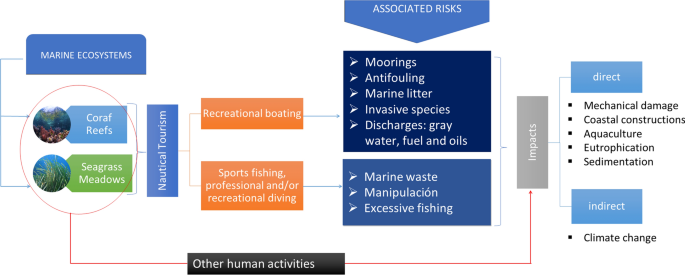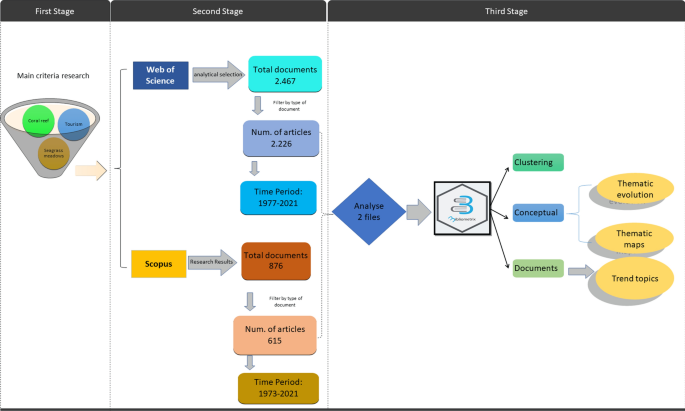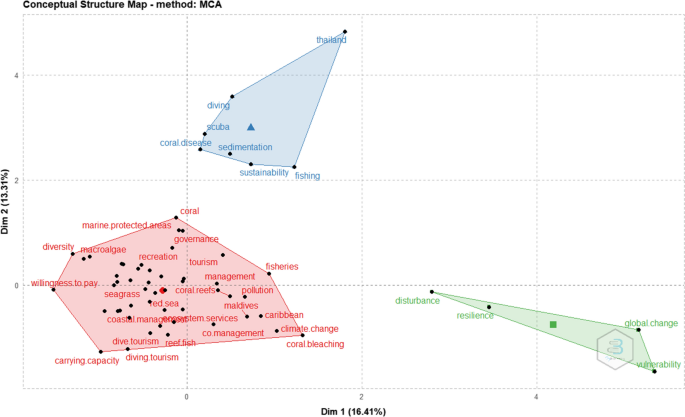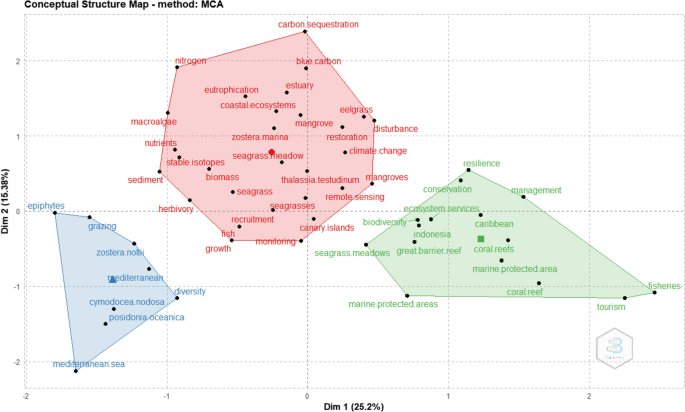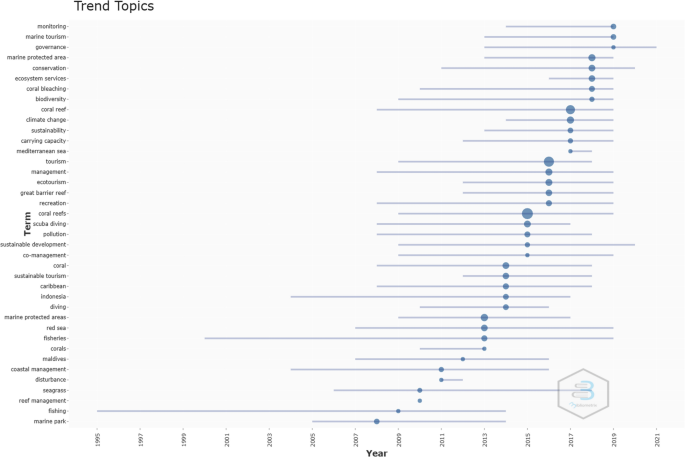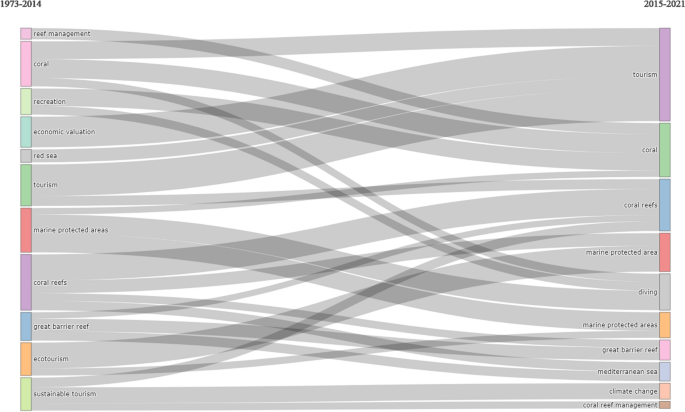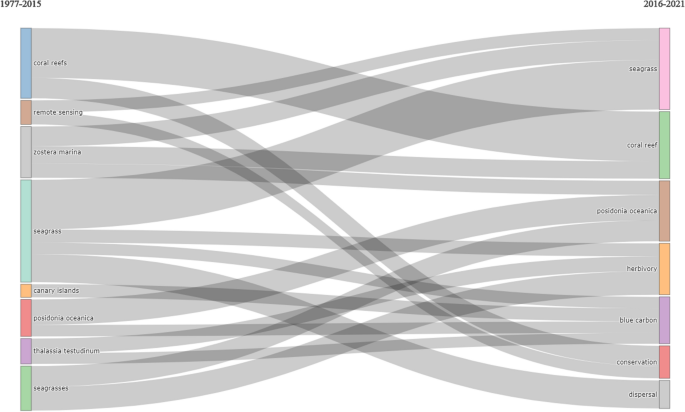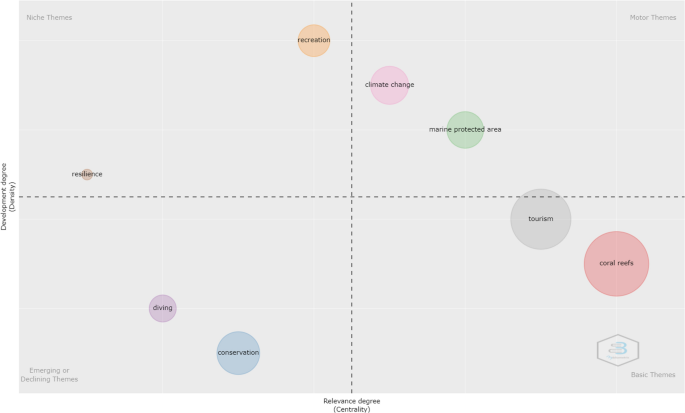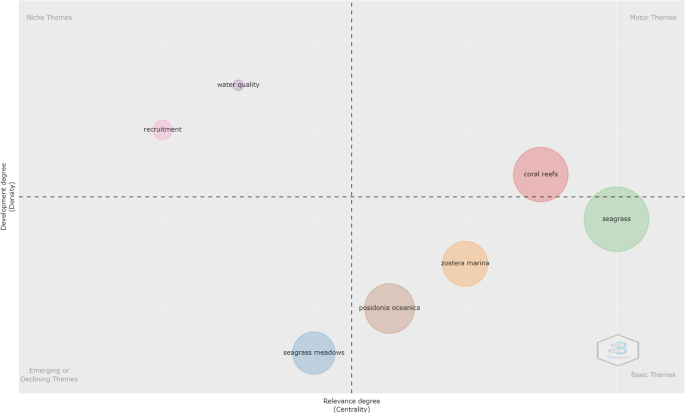- Research
- Open access
- Published:
Analysis and global research trends on nautical tourism and green coastal infrastructures: the case of coral reefs and seagrass meadows
Environmental Sciences Europe volume 34, Article number: 33 (2022)
Abstract
Background
This article aims to analyse the scientific production related to the impact worldwide of recreational and sports tourism on the conservation and management of coast and marine green infrastructures. To this end, the research focuses on two of the ecosystems, where this type of tourism exerts pressure on a global scale: seagrass meadows and coral reefs. Based on Scopus and WoS databases, different levels of analysis have been carried through the application of bibliometrics to identify the most prevalent topics and future research trends.
Results
The main results are summarised as follows. On the one hand, many publications in the scientific sector analyse how tourism and recreational activity affect specific marine ecosystems, especially coral reefs. On the other hand, the phenomenon of Global Change and the social and environmental effects on marine ecosystems with significant tourism potential have been identified as one of the most studied research topics. Finally, emerging research trends have been identified, including environmental monitoring and tracking programs aimed at controlling tourism, aspects related to the participation of the population and local tourism sectors, and the role of ecotourism in marine protected areas.
Conclusions
In conclusion, a greater commitment from the public administration and a greater social awareness of the ecosystem services it generates is needed. If the species and the natural environment are not conserved and protected, the tourist attractiveness of these areas would be lost and, ultimately, the tourism of the area would change, with the consequent loss of well-being for the whole community.
Introduction
Historically, mainstream economics has not valued the environmental services provided by natural ecosystems. However, recent research shows that the economic value of natural ecosystems, in terms of their contribution to human health and well-being, has an economic value between 10 and 100 times greater than the cost related to its conservation [7, 15, 34, given that they are responsible for such important environmental services as climate change protection, food security and reduced risk of environmental disasters and diseases.
Regarding nature-based solutions, green infrastructures take on an enormous role. Green Infrastructure is defined as a strategically planned network of natural and semi-natural spaces and other environmental elements designed and managed to offer a wide range of ecosystem services [25]. This novel term tries to simplify complex ecological concepts related to the functioning of ecosystems and the environmental services they provide, making an analogy between the infrastructure of natural systems and artificial human systems, known as Grey Infrastructure, such as roads, electrical networks, or hydraulic infrastructures.
Green infrastructure is presented as an important resource to achieve and maintain the health of aquatic and coastal ecosystems and offer multiple benefits related to increasing water availability for different uses: water purification, conservation and protection of aquatic biodiversity, as well as adaptation and mitigation of the effects of climate change, such as sea level rise, increased flooding, torrential rains or long periods of drought [57, 68].
Based on the Common International Classification of Ecosystem Services (CICES) [32], these environmental services are divided into three categories:
-
Provisioning: services that nature provides directly to the population. These are vital for the survival and well-being of society, and a market price is applied to them.
-
Regulation: services provided by the ecological processes in nature, giving it the necessary resilience to resist or adapt to anthropic pressures.
-
Cultural: services related to the enjoyment of nature that contribute to human beings' personal or spiritual development.
Green infrastructure includes green spaces and other physical elements in terrestrial (natural, rural and urban) and marine areas [25]. Marine green infrastructure encompasses multifunctional marine areas of high ecological value, essential for the functioning of the marine ecosystem, as well as for the provision of key environmental services, such as water quality, recreational spaces, climate change mitigation and biodiversity conservation [62, 65]. On the other hand, the term marine green infrastructure also helps to indicate possible linkages with green infrastructure in coastal areas and on land [62].
In rural and urban terrestrial areas, the concept of green infrastructure is widely accepted; however, in the marine domain, its application is more novel, due according to certain authors to the scarcity of spatial data and the dynamic nature of the marine ecosystem [62]. In relation to this, one of the most important challenges is to establish a methodology to analyse the connectivity between marine ecosystems with each other and with terrestrial ecosystems.
The delineation of marine green infrastructure, as with terrestrial green infrastructure, can encompass several criteria that characterise the marine ecosystem, its biological values, its functionality and the provision of services.
Coastal and marine green infrastructures, such as coral reefs and seagrass meadows, two of the marine ecosystems that receive the most pressure from nautical and recreational activities, such as sport diving on a global scale [10, 37], provide key environmental services for the well-being and development of the world's coastal and littoral populations (Table 1). Coral reefs and seagrass meadows provide a series of critical environmental services, such as the protection and defence of coastal populations against increasingly common extreme weather events (devastating rains and floods) linked to climate change, serving as a refuge and breeding areas for marine species which are of interest to the fishing industry, and the mitigation of the greenhouse effect through the fixation of organic carbon (blue carbon) [53, 72, 75].
However, the increasing human pressure on most touristic coastal areas is causing a deterioration of their natural resources and marine habitats, as well as a loss and deterioration of the essential environmental services provided by marine ecosystems, such as coral reefs and seagrass beds.
Recreational and tourist services are particularly important, because they represent one of the primary sources of job creation and economic development in coastal regions worldwide. According to the World Tourism Organisation, 80% of international tourism takes place in coastal areas, more than 183 countries have coastlines, and 37% of the world's population lives in coastal regions [74].
To address the study of global research trends on the sustainability of nautical and recreational tourism and its effects on marine green infrastructures precisely, this bibliometric analysis has focused on two of the most fragile marine ecosystems on a planetary scale (Fig. 1) and most demanded by nautical, recreational and sports tourism: coral reefs and seagrass meadows. These green infrastructures are one of the most popular resources for tourists, mainly due to the diversity of species they harbour, which has led to an exponential growth in recent decades in activities, such as professional and recreational diving, sport fishing and nautical tourism [37]. Its practice is not risk-free and can produce negative externalities on the environment. For example, nautical recreational activities carried out in pleasure boats generate three types of environmental impacts: polluting the marine environment, the transport of invasive species, and the degradation of the seabed [10]. Along these lines, if we look at the classification of damages to seagrass meadows, Duarte [21] distinguishes direct and indirect impacts caused by human activity. The former has to do with mechanical damage (fishing, anchoring, dredging), coastal constructions, aquaculture, eutrophication, and sedimentation, while the latter focus on the effects of climate change (increased extreme weather events, rising sea levels, and ultraviolet radiation, etc.).
Given the current and future relevance of tourism activities and their impact on the conservation and management of marine green infrastructures for the well-being and development of many of the planet's coastal populations, such as reefs and seagrass meadows, in this study, we address the research trends associated with this issue.
The main contribution of this research is linked with the usefulness that marine infrastructures can provide to the development of coastal, nautical and maritime tourism for sustainable growth, under ecological and social responsibility.
The findings are relevant for researchers, professionals, and researchers focused on marine green infrastructures and nature-based solutions as tools to face current global environmental problems, such as climate change and other environmental risks, marine pollution, loss of biodiversity, or the risk posed by introducing exotic species. The results may also be of great interest to researchers focused on aspects of sustainable tourism in marine and coastal areas.
Methodology
In the first phase, the search criteria were limited to tourism, coral reefs and seagrass meadows, mainly due to a growing awareness of the importance of preserving marine meadows which are currently being overexploited as a result of human activity, particularly those related to tourism.
In the second phase, of the selected elements, "tourism" and "coral reef," or "seagrass meadows", a total of 876 documents were obtained in the Scopus database. These were then filtered by articles (615) for the period 1973–2021. For the WoS database, a total of 2,467 documents and 2,226 articles were obtained for the period 1977–2021.
In the third phase, both databases were processed to perform a more complete analysis of the scientific production through bibliometrix, an R software package with a user-friendly interface [1]. This tool offers analysis at different levels: sources, authors, and documents. In addition, it offers an analysis of the clusters and the conceptual structure of a scientific field, which is very useful for interpreting the results obtained through thematic evolution, thematic maps, and trend themes (Fig. 2).
Results and discussion
Clustering analysis
An initial analysis was carried out on the conceptual structure, in two dimensions: dimension 1 on the x-axis is the variable "documents", while dimension 2 on the y-axis is the variable "keywords". After applying the clustering algorithm, different bibliometric maps were obtained depending on the type of database used (WoS or Scopus) centred on Author Keywords. The size of the clusters in each bibliometric map was determined by the number of terms and their weight or similarity index. The colour of each cluster was randomly assigned. The proximity between words corresponds to shared substance: keywords are close to each other, because a large proportion of articles treat them together.
After executing different tests, it was decided to analyse the bibliometric maps resulting from the Author Keywords as these differentiated the thematic groups more consistently.
Figure 3 shows the clusters according to Scopus. The Blue Cluster, made up of seven items, integrates research related to the problem that coral reefs are suffering as a consequence of the impact of tourist activities, especially significant in Thailand [5, 16, 36, 59, 78]. This section includes research related to the study of both direct and indirect effects of tourism activities on the natural and fisheries resources of coral reefs. In the scientific literature that addresses this issue, there is a wide variety of research related to the impacts generated by tourist activity, both directly (such as the effects of recreational diving) and indirectly (such as pollution from sewage or increased sedimentation or turbidity of the waters surrounding coral reefs as a result of dredging operations in ports) [17, 33, 41, 44, 60, 77].
The large number of scientific publications about recreational diving in coral reefs is due to the fact that it is an activity in current expansion, to the point that it is a tourist market of economic importance for close to 100 countries and territories [66].
The Green Cluster, comprising of four items, encompasses research related to the vulnerability of coral reefs and seagrass meadows to the effects of Global Change [39, 67, 73]. In the case of corals, this cluster would include research related to the threat posed to this type of green infrastructure by the warming and acidification of the oceans because of the increase in atmospheric CO2 and the indirect consequences of this problem for related tourism industries.
The research in this section concludes that Climate Change poses a direct threat to coral reefs and seagrasses. For example, the increase in the frequency and intensity of hurricanes attributed to climate change affects the natural resilience of these ecosystem types [54, 76]. Another direct cause of climate change is that the increase in CO2 levels affects the chemistry of the oceans, causing an increase in their acidity and, therefore, a reduction in the calcification capacity of coral skeletons [40, 71].
In relation to this last aspect, this cluster also includes another group of research linked to the use as indicators for making projections on the effects of Global Change, the changes that are occurring in these marine green infrastructures, such as coral bleaching or the reduction in the surface area of certain seagrass meadows, such as posidonia oceanica [27, 42, 58, 56].
The Red Cluster encompasses a broad set of keywords related to the conservation and management of these ecosystems and the environmental services they provide [2, 6, 11], as well as human activities that impact them. Tourism activities stand out due to their frequency of appearance in the cluster [3, 26, 2961, 79].
This cluster would also include a frequent group of publications aimed at studying the tourist carrying capacity of different coral reef and seagrass areas around the world [55, 64]. On the other hand, this cluster would also include social and economic research related to the impact that the environmental degradation of this type of green infrastructure has on the tourism operators linked to it [20].
In Fig. 4, and regarding the WoS database, the Blue Cluster comprises eight items, including publications related to the conservation and study of the diversity of Mediterranean seagrass meadows [13, 46, 49, 70].
The appearance of this cluster highlights the existing scientific interest in studying aspects related to the biology and ecology of this type of green infrastructure in Mediterranean marine ecosystems. The Green Cluster, made up of 15 items, includes the line of research mentioned in the previous bibliometric map of the Scopus database, referring to the study of environmental services and their social benefits linked to the conservation and management of these marine ecosystems (coral reefs and seagrass meadows).
In this sense, both the blue cluster and the green cluster highlight the importance of research related to the important environmental services provided by these green infrastructures, such as their role as carbon sinks, in preventing beach erosion by attenuating waves and fixing sand, or as key refuge and breeding sites for species of commercial interest [9, 53].
From the point of view of tourism, it is worth highlighting research that attempts to demonstrate the relationship between the environmental degradation of these green infrastructures and the loss of the value tourists perceive from the underwater environment, with the aim of defending the need to carry out management based on the conservation and sustainable use of these valuable ecosystems [79].
The Red Cluster includes a broad set of items related to the role that seagrass meadows and their sediments play as a carbon store ("blue carbon", "carbon sequestration") and, therefore, as an aid for the mitigation of Climate Change [4, 30, 43, 47, 63, 69, 72]. Research in this area is providing results that indicate that seagrasses are a key ecosystem type for organic carbon storage.
Finally, concerning the bibliometric map of the WoS database, the absence of research related to the influence of tourism on the conservation of coral reefs and seagrass meadows stands out, an area of study which is clearly present in the Scopus database.
Trend analysis
The graphs depicting the evolution of the research topics are presented below. The vertical nodes represent a group of keywords, and the edges show their evolution over time. The total of co-occurrences gives the size of the cluster.
The most recent research trends (Fig. 5) are reflected by the keywords "surveillance", "marine tourism", and "governance". A second, more traditional trend is represented by the keywords "marine protected areas", "conservation", "environmental services", and "coral bleaching".
Given these results, the following leading lines of research are proposed:
-
Among research related to coral reefs and seagrasses, there has recently been a growing interest in aspects related to monitoring and surveillance monitoring, marine tourism and governance.
-
We understand that the interest in monitoring may be due to the fact that these ecosystems have suffered an accelerated process of decline and environmental deterioration in recent years [31].
-
On the other hand, the appearance of the keywords "marine tourism" and "governance" among the most current research trends points to an increase in research related to the consequences of touristic use of these green infrastructures, as well as the role played by the population in their conservation and management [10, 14, 35, 41].
-
Somewhat less novel, but also important, is research related to environmental services and the conservation of marine protected areas [19, 35, 38, 45].
Overall, there is some evolution in research trends. In the period 2007–2013, research related to fisheries and marine protected areas were of greater interest; in the period 2014–2016, coinciding precisely with the growth of nautical tourism activities, issues related to the sustainability of tourism activities are becoming more important. In the 2017–2018 period, other issues that also affect the conservation of these ecosystems, such as climate change, biodiversity or carrying capacity in marine protected areas, began to dominate, until today, when topics such as monitoring, surveillance and governance are more important.
Analysis of thematic evolution
According to Scopus, Fig. 6 represents the evolution of the thematic areas, divided into two periods: the first, 1973–2014, is shown in the left column, and the second, 2015–2021, is shown on the right. The following substantial changes are observed:
-
On the one hand, the term "coral" starts as a single topic and diverges towards topics related to tourism and diving. Likewise, there is an evolution of the concept "recreation" towards the terms "coral" and "diving". This evolution seems to highlight the scientific community's interest in diving tourism in coastal areas and coral reefs due to the relevance of this tourist activity to the areas' economic development and the deterioration and impact that this activity produces in these sensitive green infrastructures.
-
In addition, there is an evolution of the "economic evaluation" concept towards the concept of tourism, which once again highlights the scientific interest in evaluating the impact of tourism activity in coastal areas.
-
Finally, an evolution is observed from the concept "marine protected areas" towards the term "diving", from the concept "coral reefs" towards "marine protected area", from the concept "ecotourism" to that of "marine protected areas". This is evidence of the scientific interest in research related to ecotourism in marine protected areas.
Figure 7 identifies the evolution of the term "coral reefs" towards the concept of "conservation" and of the terms "Posidonia oceanica", "Thalassia testudinum", and "seagrasses" towards that of "blue carbon", evidence of the growing interest in research related to coral reef conservation and the role seagrass meadows play as carbon stores (blue carbon) to mitigate the effects of climate change. For example, a study has shown that one hectare of Posidonia oceanica meadow has the capacity to sequester and remove the same amount of carbon from the atmosphere as 17 hectares of pristine Amazonian forest [28].
Thematic map analysis
There are different ways of analysing the themes of a research field. The strategy diagram offers an interesting means of classifying thematic maps of a research field through keywords. This is a proposal by Callon, Courtilan and Laville (1991). The strategy map is obtained by applying a clustering algorithm on the network of words represented in a coordinate system composed of centrality (x-axis) and density (y-axis), differentiating four zones according to these two variables. The first quadrant addresses motor issues; the second quadrant addresses basic and cross-cutting issues; the third quadrant relates to highly developed and isolated issues; and the fourth quadrant groups emerging or declining issues [8, 12].
That said, from the point of view of Scopus and Keywords Plus (Fig. 8) that the basic themes are "tourism" and "coral reefs". As driving research themes, the most developed are "climate change" and "marine protected areas".
"Recreation" and "sustainability" appear as specific themes, as do "resilience" and "climate change", with diving and conservation being the declining themes.
As noted in the results of the previous sections, Fig. 8 shows the environmental, economic and social importance of tourism on coral reefs, as well as the risk posed by climate change to this type of green infrastructure.
For WoS (Fig. 9), the Author Keywords, "water quality" and "recruitment", stand out as specific and highly developed themes. In this regard, as noted above, ocean acidification as a consequence of the effects of climate change is an issue of concern, because it causes a reduction in the calcification capacity of coral skeletons [40, 71].
"Coral reefs" appear as highly developed and central themes. "Seagrass meadows" appear as an emerging theme, positioning it as an essential piece in carbon sequestration and other benefits in the form of ecosystem services and, therefore, of economic value [52]. Indeed, the progressive loss of seagrass meadows increases emissions and accelerates climate change [50, 51]. The core topics focus on seagrass species such as marine eelgrass and Posidonia oceanica providing essential services for maritime-coastal ecosystems and human well-being.
Conclusions
The results provide a series of general ideas (volume, evolution, trends, and areas) on the current state of a field of research focused on the global impact of coastal tourism on the conservation and management of two of the key marine ecosystems, such as seagrass meadows and coral reefs.
The more significant development and employment opportunities that the tourism sector offers in these coastal areas have led to a considerable increase in the population of the coastal areas, where these habitats have developed in recent decades. As identified in this study, this population growth has led to major socio-economic and environmental changes.
First, the results suggest great interest in studying how tourism and recreational activities affect marine ecosystems. Of particular note is the scientific production related to the study of the impact of diving and nautical tourism activities on the coral reefs. Similarly, the academic community is also interested in research on the need for a greater commitment by the public administration and society in general to carry out tourism management of these infrastructures based on conservation and sustainable use.
What these publications try to demonstrate is that the tourism potential of these spaces is closely related to their ecosystem values. If they are not preserved, there is a risk of losing the economic benefits associated with tourism. That said, it is interesting to value the figure of the coastal informer as a facilitator between the public administration and society, with the aim of raising community awareness of the ecosystem services that marine infrastructures provide for our well-being.
Another prevalent research topic in this area of knowledge is related to the effects that the Global Change phenomenon is having on the key environmental services that these marine ecosystems provide to the local population and the future impact that the tourism sector may have in these areas, whether negatively, accelerating these processes of change, or positively, favouring the conservation and resilience of these ecosystems.
In relation to this section, the results of this study have detected two aspects of great scientific interest. On the one hand, the increasingly evident impact of climate change on coral reefs due to ocean acidification, which causes the deterioration and collapse of this type of ecosystem. In addition, on the other hand, issues related to the fundamental role that seagrasses play as a CO2 sink and, therefore, in contributing to the mitigation of the impacts of climate change.
The environmental and socio-economic effects that Climate Change has on these ecosystems, coral reefs, and seagrass meadows highlight the need to work with public administrations (national, regional, and local) and non-governmental agents to develop governance processes aimed at strengthening the community coastal organisation and agree on long-term policies for the management and conservation of natural resources, as well as the management of natural risks.
In this sense, it is vital when developing public policies to consider the formulation of regulations and procedures that encompass good ecological practices that benefit all the agents involved, both from the economic point of view and that of community social development.
On the one hand, this study has identified as main research trends, environmental monitoring and tracking programs aimed at controlling tourism through indicators of "biological quality", such as seagrass meadows and coral reefs, aspects related to the participation of the population and local tourism sectors in the management and conservation of these marine ecosystems and, finally, the role of ecotourism in marine protected areas.
However, this work is not without its limitations. Only the role of tourism in two types of marine ecosystems, seagrass meadows and coral reefs, have been analysed. Although these ecosystems have the greatest tourism potential on a planetary scale, it would be interesting to repeat this bibliometric analysis process for other marine ecosystems and compare the results with this work to analyse their differences and similarities.
In relation to futures lines of research, it is necessary to conduct more research on the economic valuation of the environmental services provided by this type of marine green infrastructure. The results of this line of research would facilitate the evaluation of their natural capital, which in turn would greatly support decision-making processes and an understanding of the economic losses that could lead to the deterioration or disappearance of these marine ecosystems.
Availability of data and materials
The data sets used and/or analyzed during the current study are available from the corresponding author on request.
References
Aria M, Cuccurullo C (2017) Bibliometrix: an R-tool for comprehensive science mapping analysis. J Informetr 11(4):959–975. https://doi.org/10.1016/j.joi.2017.08.007
Baker S, Paddock J, Smith AM, Unsworth RK, Cullen-Unsworth LC, Hertler H (2015) An ecosystems perspective for food security in the Caribbean: seagrass meadows in the Turks and Caicos Islands. Ecosyst Serv 11:12–21
Beck MW, Losada IJ, Menéndez P et al (2018) The global flood protection savings provided by coral reefs. Nat Commun 9:2186. https://doi.org/10.1038/s41467-018-04568-z
Bertram C, Quaas M, Reusch TB, Vafeidis AT, Wolff C, Rickels W (2021) The blue carbon wealth of nations. Nat Clim Chang 11(8):704–709
Biggs D, Hall CM, Stoeckl N (2012) The resilience of formal and informal tourism enterprises to disasters: reef tourism in Phuket, Thailand. J Sustain Tour 20(5):645–665
Brodersen MM, Pantazi M, Kokkali A, Panayotidis P, Gerakaris V, Maina I et al (2018) Cumulative impacts from multiple human activities on seagrass meadows in eastern Mediterranean waters: the case of Saronikos Gulf (Aegean Sea, Greece). Environ Sci Pollut Res 25(27):26809–26822
Buckley R, Brough P, Hague L, Chauvenet A, Fleming C, Roche E et al (2019) Economic value of protected areas via visitor mental health. Nat Commun 10(1):1–10
Callon M, Courtial JP, Laville F (1991) Co-word analysis as a tool for describing the network of interactions between basic and technological research: the case of polymer chemistry. Scientometrics 22(1):155–205
Campagne CS, Salles J-M, Boissery P, Deter J (2015) The seagrass Posidonia oceanica: ecosystem services identification and economic evaluation of goods and benefits. Mar Pollut Bull 97(1–2):391–400
Cerchiello G (2018) La sostenibilidad de la náutica de recreo. Estudio de caso del fondeo de las embarcaciones en Jávea (Alicante). Investig Turísticas. https://doi.org/10.14198/INTURI2018.16.09
Chand S, Bollard B (2021) Low altitude spatial assessment and monitoring of intertidal seagrass meadows beyond the visible spectrum using a remotely piloted aircraft system. Estuar Coast Shelf Sci 255:107299
Cobo MJ, López-Herrera AG, Herrera-Viedma E, Herrera F (2011) Science mapping software tools: review, analysis, and cooperative study among tools. J Am Soc Inform Sci Technol 62(7):1382–1402
Como S, Magni P, Baroli M et al (2008) Comparative analysis of macrofaunal species richness and composition in Posidonia oceanica, Cymodocea nodosa and leaf litter beds. Mar Biol 153:1087–1101. https://doi.org/10.1007/s00227-007-0881-z
Curnock MI, Marshall NA (2019) Changes in the state of Great Barrier Reef tourism from 2013 to 2017: a report from the Social and Economic Long-Term Monitoring Program (SELTMP). Report prepared for the Great Barrier Reef Marine Park Authority. CSIRO Land and Water, Townsville.
De Groot R, Brander L, Van Der Ploeg S, Costanza R, Bernard F, Braat L et al (2012) Global estimates of the value of ecosystems and their services in monetary units. Ecosyst Serv 1(1):50–61
Dearden P, Bennett M, Rollins R (2007) Perceptions of diving impacts and implications for reef conservation. Coast Manag 35(2–3):305–317
Dearden P, Theberge M, Yasué M (2010) Using underwater cameras to assess the effects of snorkeler and SCUBA diver presence on coral reef fish abundance, family richness, and species composition. Environ Monit Assess 163:531–538. https://doi.org/10.1007/s10661-009-0855-3
Deloitte Access Economics (2017) At what price? The economic, social and icon value of the Great Barrier Reef. Report to the Great Barrier Reef Foundation. https://www2.deloitte.com/content/dam/Deloitte/au/Documents/Economics/deloitte-aueconomics-great-barrier-reef-230617.pdf.
Díaz M, Fietz K, Forcada A, Ford A, García-Charton JA, Goñi R, Lenfant P, Mallol S, Mouillot D, Pérez-Marcos M, Puebla O, Manel S, Pérez-Ruzafa A (2021) Reviewing the ecosystem services, societal goods, and benefits of marine protected areas. Front Mar Sci 8:613819. https://doi.org/10.3389/fmars.2021.613819
Dimopoulos D, Queiros D, Van Zyl C (2019) Sinking deeper: the most significant risks impacting the dive tourism industry in the East African Marine Ecoregion. Ocean Coast Manag 181:104897. https://doi.org/10.1016/j.ocecoaman.2019.104897 (ISSN 0964-5691)
Duarte CM (2002) The future of seagrass meadows. Environ Conserv 29(2):192–206
Duarte CM, Kennedy H, Marbà N, Hendriks I (2011) Assessing the capacity of seagrass meadows for carbon burial: current limitations and future strategies. Ocean Coast Manag 83:32–38
Duarte CM, Middelburg JJ, Caraco N (2005) Major role of marine vegetation on the oceanic carbon cycle. Biogeosciences 2:1–8
Duarte CM, Marbà N, Gacia E, Fourqurean JW, Beggins J, Barrón C, Apostolaki ET (2010) Seagrass community metabolism: assessing the carbon sink capacity of seagrass meadows. Glob Biochem Cycles 24:GB4032
European Commission. Building a Green Infrastructure for Europe (2014) https://ec.europa.eu/environment/nature/ecosystems/docs/GI-Brochure-210x210-ES-web.pdf. Accessed 21 June 2021.
Trégarot E, Failler P, Maréchal J-P (2017) Evaluation of coastal and marine ecosystem services of Mayotte: Indirect use values of coral reefs and associated ecosystems. Int J Biodivers Sci Ecosyst Serv Manage 13(3):19–34. https://doi.org/10.1080/21513732.2017.1407361
Foster N, Attrill M (2021) Chapter 20—Changes in coral reef ecosystems as an indication of climate and global change. In: Letcher TM (ed) Climate change, 3rd edn. Elsevier, pp 427–443
Fourqurean JW, Duarte CM, Kennedy H, Marbà N, Holmer M, Mateo MA, Apostolaki E, Kendrick GA, Krause-Jensen D, Mc Glatheryand KJ, Serrano O (2012) Seagrass ecosystems as a globally significant carbon stock. Nat Geosci. https://doi.org/10.1038/Ngeo1477
Graham NAJ, Nash KL (2013) The importance of structural complexity in coral reef ecosystems. Coral Reefs 32(2):315–326
Greiner JT, McGlathery KJ, Gunnell J, McKee BA (2013) Seagrass restoration enhances “blue carbon” sequestration in coastal waters. PLoS ONE 8(8):e72469
Güreşen A, Pergent G, Güreşen SO, Aktan Y (2020) Evaluating the coastal ecosystem status of two Western and Eastern Mediterranean islands using the seagrass Posidonia oceanica. Ecol Indic 108:105734
Haines-Young R, Potschin MB (2018) Common international classification of ecosystem services (CICES) V5.1 and guidance on the application of the revised structure.
Hall E, Muller E, Goulet T, Bellworthy J, Ritchie K, Fine M (2018) Eutrophication may compromise the resilience of the Red Sea coral Stylophora pistillata to global change. Mar Pollut Bull 131(Part A):701–711
Hamann F, Blecken GT, Ashley RM, Viklander M (2020) Valuing the multiple benefits of blue-green infrastructure for a Swedish case study: contrasting the economic assessment tools B£ ST and TEEB. J Sustain Water Built Environ 6(4):05020003
Heber K (2021) Adaptive governance: the proposed port expansion in the Cayman Islands and its impacts to coral reefs. Mar Policy 124:104248
Hein MY, Lamb JB, Scott C, Willis BL (2015) Assessing baseline levels of coral health in a newly established marine protected area in a global scuba diving hotspot. Mar Environ Res 103:56–65
Hilmi N, Safa A, Reynaud S, Allemand D (2012) Coral reefs and tourism in Egypt’s Red Sea. Top Middle East Afr Econ 14:416–434
Hogg K, Semitiel-García M, Noguera-Méndez P, García-Charton J (2021) A Governance analysis of Cabo de Palos-Islas Hormigas and Cabo de Gata-Níjar marine protected areas. Spain. Mar Policy 127:102944
Johnson RA, Gulick AG, Bolten AB, Bjorndal KA (2019) Rates of sediment resuspension and erosion following green turtle grazing in a shallow Caribbean Thalassia testudinum meadow. Ecosystems 22(8):1787–1802
Knowlton N (2001) The future of coral reefs. Proc Natl Acad Sci US 98(10):5419–5425
Koh E, Fakfare P (2020) Overcoming “over-tourism”: the closure of Maya Bay. Int J Tour Cities 6(2):279–296. https://doi.org/10.1108/IJTC-02-2019-0023
Kornder NA, Riegl BM, Figueiredo J (2018) Thresholds and drivers of coral calcification responses to climate change. Glob Change Biol 24(11):5084–5095. https://doi.org/10.1111/gcb.14431
Krause-Jensen D, Duarte CM (2016) Substantial role of macroalgae in marine carbon sequestration. Nat Geosci 9(10):737–742
Lachs L, Oñate-Casado J (2020) Fisheries and tourism: Social, economic, and ecological trade-offs in coral reef systems. In: Jungblut S, et al. Eds. YOUMARES 9—the oceans: our research, our future: Proceedings of the 2018 conference for Young Marine Researcher in Oldenburg, Germany, Springer International Publishing, pp 243–260.
Lara-Pulido JA, Mojica Á, Bruner A, Guevara-Sanginés A, Simon C, Vásquez-Lavin F, González-Baca C, Infanzón MJ (2021) A business case for marine protected areas: economic valuation of the reef attributes of Cozumel Island. Sustainability 13:4307. https://doi.org/10.3390/su13084307
Mabrouk L, Brahim M, Hamza A, Mahfoudhi M, Najmeddine M (2014) A comparison of abundance and diversity of epiphytic microalgal assemblages on the leaves of the seagrasses Posidonia oceanica (L.) and Cymodocea nodosa (Ucria) asch in Eastern Tunisia. J Mar Sci 2014, Article ID 275305, 10 pp.
Macreadie PI, Anton A, Raven JA, Beaumont N, Connolly RM, Friess DA et al (2019) The future of Blue Carbon science. Nat Commun 10(1):1–13
Mangos A, Bassino J-P, Sauzade D (2010) Valeur économique des bénéfices soutenables provenant des écosystèmes marins méditerranéens. Plan Bleu. https://planbleu.org/projets/lesecosystemes-marins-mediterraneens-valeur-economique-des-benefices-soutenables/
Mateu-Vicens G, Khokhlova A, Sebastián-Pastor T (2014) Epiphytic foraminiferal indices as bioindicators in Mediterranean seagrass meadows. J Foraminifer Res 44(3):325–339
Mazarrasa I, Samper-Villarreal J, Serrano O, Lavery PS, Lovelock CE, Marbà N et al (2018) Habitat characteristics provide insights of carbon storage in seagrass meadows. Mar Pollut Bull 134:106–117
McKenzie LJ, Nordlund LM, Jones BL, Cullen-Unsworth LC, Roelfsema C, Unsworth RK (2020) The global distribution of seagrass meadows. Environ Res Lett 15(7):074041
Micheletti T, Jost F, Berger U (2016) Partitioning stakeholders for the economic valuation of ecosystem services: examples of a mangrove system. Nat Resour Res 25(3):331–345
Monnier B, Pergent G, Mateo MÁ, Carbonell R, Clabaut P, Pergent-Martini C (2021) Sizing the carbon sink associated with Posidonia oceanica seagrass meadows using very high-resolution seismic reflection imaging. Mar Environ Res 170:105415
Naim O, Chabanet P, Done T, Tourrand C, Letourneur Y(2000) Regeneration of a reef flat ten years after the impact of the cyclone Firinga (Reunion, SW Indian ocean). In: 9th international coral reef symposium, Oct 2000, Bali, Indonesia. pp.547–554. ⟨hal-00913738⟩
Naranjo-Arriola A (2021) Tourist carrying capacity as a sustainability management tool for coral reefs in Caño Island Biological Reserve, Costa Rica. Ocean Coast Manag 212:2021. https://doi.org/10.1016/j.ocecoaman.2021.105857
Nguyen H, Ralph P, Marín-Guirao L, Pernice M, Procaccini G (2021) Seagrasses in an era of ocean warming: a review. Biol Rev. https://doi.org/10.1111/brv.12736,96,5,(2009-2030)
Palmer M, Liu J, Matthews J, Mumba M, D´Odorico P (2015) Water security: gray or green? Science 7.
Pansini A, La Manna G, Pinna F, Stipcich P, Ceccherelli G (2021) Trait gradients inform predictions of seagrass meadows changes to future warming. Sci Rep. https://doi.org/10.1038/s41598-021-97611-x,11,1
Pascoe S, Doshi A, Thébaud O, Thomas CR, Schuttenberg HZ, Heron SF et al (2014) Estimating the potential impact of entry fees for marine parks on dive tourism in South East Asia. Mar Policy 47:147–152
Reopanichkul P, Schlacher TA, Carter RW, Worachananant S (2009) Sewage impacts coral reefs at multiple levels of ecological organisation. Mar Pollut Bull 58(9):1356–1362
Pergent-Martini C, Pergent G, Monnier B, Boudouresque Ch, Mori Ch, Valette-Sansevin A (2021) Contribution of Posidonia oceanica meadows in the context of climate change mitigation in the Mediterranean Sea. Mar Environ Res 165:105236
Piet GJ, Strosser P, Zamaprutti T, Ruskule A, Veidemane K, Dworak TN, Milkova T (2021) A practical approach toward an ecosystem-based approach in maritime spatial planning. European Commission
Piñeiro-Juncal N, Díaz-Almela E, Leiva-Dueñas C, Deulofeu O, Frigola J, Soler M, Martinez-Cortizas A, Giralt S, Garcia-Orellana J, Mateo M (2021) Processes driving seagrass soils composition along the western Mediterranean: The case of the southeast Iberian Peninsula. Sci Total Environ 768:144352
Reza M, Mohammadi M (2021) Effects of recreational SCUBA diving on coral reefs with an emphasis on tourism suitability index and carrying capacity of reefs in Kish Island, the northern Persian Gulf. Reg Stud Mar Sci 45:101813
Ruskule A, Bergström L, Schmidtbauer J, Kotta J, Arndt P, Strāķe S, Sprukta S, Ustups D, Urtāne I (2019) Mapping of marine green infrastructure: pan Baltic scope approach. Panbaltic Scope. Ministry of Environmental Protection and Regional Development of the Republic of Latvia 2019
Santander L (2009) Impactos turismo buceo en arrecifes coralinos. Caso Cozumel, Tesis grado, PH. https://doi.org/10.13140/RG.2.1.4947.5927.
Schlacher-Hoenlinger MA, Schlacher TA (1998) Differential accumulation patterns of heavy metals among the dominant macrophytes of a Mediterranean seagrass meadow. Chemosphere 37(8):1511–1519
Schoonees T, Gijon A, Scheres B, Bouma TJ, Silva R, Schlurmann T, Schüttrumpf H (2019) Hard Structures for coastal protection, towards greener designs. Estuar Coasts 42:1709–1729
Serrano O, Kelleway J, Lovelock C, Lavery P (2019) Chapter 28—conservation of blue carbon ecosystems for climate change mitigation and adaptation. In: Perillo GME, Wolanski E, Cahoon DR, Hopkinson CS (eds) Coastal wetlands. Elsevier, pp 965–996
Siljeström PA, Rey J, Moreno A (1996) Characterisation of phanerogam communities (Posidonia oceanica and Cymodocea nodosa) using side-scan-sonar images. ISPRS J Photogramm Remote Sens 51(6):308–315
Spalding MD et al (2001) World atlas of coral reefs. University of California Press, Berkeley
Stankovic M, Ambo-Rappe R, Carly F, Dangan-Galon F, Fortes MD, Hossain MS et al (2021) Quantification of blue carbon in seagrass ecosystems of Southeast Asia and their potential for climate change mitigation. Sci Total Environ 783:146858
Sullivan CR, Smyth AR, Martin CW, Reynolds LK (2021) How does mangrove expansion affect structure and function of adjacent seagrass meadows? Estuar Coasts 44(2):453–467
United Nations World Tourism Organisation (UNWTO) (2014) UNWTO tourism highlights, 2013 Edition
Watanabe K, Kuwae T (2021) An unintended ecological benefit from human intervention: the enhancement of carbon storage in seagrass meadows. J Appl Ecol Br Ecol Soc. https://doi.org/10.1111/1365-2664.13977
Wilkinson C. Ed. (2008). Status of Coral reefs of the world: 2008. Global coral. Reef Monitoring Network y Reef and Rainforest Research Centre. Townsville.
Worachananant S, Carter RW, Hockings M, Reopanichkul P (2008) Managing the impacts of SCUBA divers on Thailand’s coral reefs. J Sustain Tour 16(6):645–663. https://doi.org/10.1080/09669580802159677
Yeemin T, Sutthacheep M, Pettongma R (2006) Coral reef restoration projects in Thailand. Ocean Coast Manag 49(9–10):562–575
Zunino S, MelakuCanu D, Marangon F, Troiano S (2020) Cultural ecosystem services provided by coralligenous assemblages and Posidonia oceanica in the Italian Seas. Front Mar Sci 6:823. https://doi.org/10.3389/fmars.2019.00823
Acknowledgements
This article has been carried out with the support of the Campus of International Excellence of the Sea (CEIMAR).
Funding
This research did not receive any specific grant from funding agencies in the public, commercial, or not-for-profit sectors.
Author information
Authors and Affiliations
Contributions
Conceptualization, JLCM, RMMV, and JPV; methodology, JLCM, RMMV, and JPV; software, JLCM, RMMV, and JPV; validation, JLCM, RMMV, and JPV; formal analysis, JLCM, RMMV, and JPV; investigation, JLCM, RMMV, and JPV; resources, JLCM, RMMV, and JPV; writing—original draft preparation, JLCM, RMMV, and JPV; All authors read and approved the final manuscript.
Corresponding author
Ethics declarations
Ethics approval and consent to participate
Not applicable.
Consent for publication
Not applicable.
Competing interests
The authors declare that they have no known competing financial interests or personal relationships that could have appeared to influence the work reported in this paper.
Additional information
Publisher's Note
Springer Nature remains neutral with regard to jurisdictional claims in published maps and institutional affiliations.
Rights and permissions
Open Access This article is licensed under a Creative Commons Attribution 4.0 International License, which permits use, sharing, adaptation, distribution and reproduction in any medium or format, as long as you give appropriate credit to the original author(s) and the source, provide a link to the Creative Commons licence, and indicate if changes were made. The images or other third party material in this article are included in the article's Creative Commons licence, unless indicated otherwise in a credit line to the material. If material is not included in the article's Creative Commons licence and your intended use is not permitted by statutory regulation or exceeds the permitted use, you will need to obtain permission directly from the copyright holder. To view a copy of this licence, visit http://creativecommons.org/licenses/by/4.0/.
About this article
Cite this article
Caparrós-Martínez, J.L., Martínez-Vázquez, R.M. & de Pablo Valenciano, J. Analysis and global research trends on nautical tourism and green coastal infrastructures: the case of coral reefs and seagrass meadows. Environ Sci Eur 34, 33 (2022). https://doi.org/10.1186/s12302-022-00614-2
Received:
Accepted:
Published:
DOI: https://doi.org/10.1186/s12302-022-00614-2
